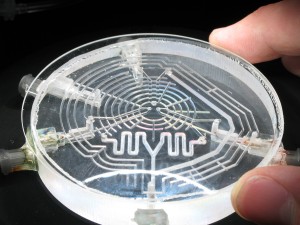Introduction
The authors present a simple and modular Microphysiological system without the use of complex components consisting of
1) a resistance module that controls the flow rate and
2) a physiologically relevant, three-dimensional blood vessel module. Flow is provided by an attached reservoir tank that feeds fluid into the resistance channel via hydrostatic pressure.
Optical Coherence Tomography (OCT) is used to measure fluid velocity at regions of interest.
Because of the system’s simplicity, it can simply be modified to include different microenvironmental components and to develop other organ-modeling systems. Due to the nature of the complexity of the modular microphysiological system, it is essential to have application-based systems so that, depending on the experiment, they can be versatile.

How to culture vascularized & immunocompetent 3D models in a standard Multiwell
Abstract
The author states that “Given the increased recognition of the importance of physiologically relevant microenvironments when designing in vitro assays, microphysiological systems (MPS) that mimic the critical function and structure of tissues and organs have gained considerable attention as alternatives to traditional experimental models.
Accordingly, the field is growing rapidly, and some promising MPS are being tested for use in pharmaceutical development and toxicological testing. However, most MPS are complex and require additional infrastructure, which limits their successful translation.
Here, we present a pumpless, modular MPS consisting of 1) a resistance module that controls the flow rate and 2) a physiologically relevant, three-dimensional blood vessel module. Flow is provided by an attached reservoir tank that feeds fluid into the resistance channel via hydrostatic pressure.
The flow rate is controlled by the height of the media in the tank and the resistance channel’s dimensions. The flow from the resistance module is streamed into the blood vessel module using a liquid bridge. We utilize optical coherence tomography (OCT) to measure fluid velocity at regions of interest.
The endothelial cells cultured in the MPS remain viable for up to 14 days and demonstrate the functional characteristics of the human blood vessels verified by tight junction expression and diffusion assay. Our results show that a modular MPS can simulate a functional endothelium in vitro while simplifying the operation of the MPS.
The simplicity of the system allows for modifications to incorporate other microenvironmental components and to build other organ-modeling systems easily.”
References
Tronolone JJ, Lam J, Agrawal A, Sung K. Pumpless, modular, microphysiological systems enabling tunable perfusion for long-term cultivation of endothelialized lumens. Biomed Microdevices. 2021 Apr 14;23(2):25. doi: 10.1007/s10544-021-00562-3. PMID: 33855605.



